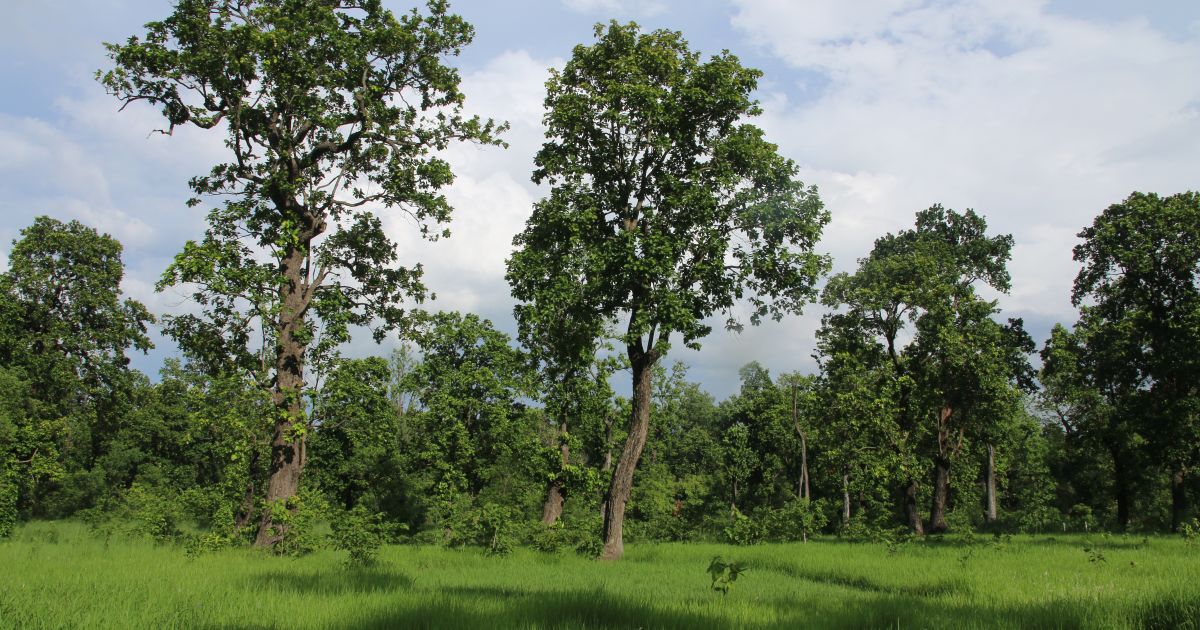
OR
Nepal’s Community Forests:An Example to the World
Published On: May 20, 2023 11:00 AM NPT By: Nimesh Adhikari

The world's forest area is shrinking due to population growth and natural disasters, but in Nepal, it has actually increased. A report published in 2015, based on a forest resources survey conducted from 2010 to 2014, showed that Nepal's forest area has rapidly expanded, thanks to the successful implementation of community forestry practices in the country.
The report states that the forest cover in the country has grown from 39.6 percent to 44.74 percent, while other wood and shrubs areas have decreased from 10.6 percent to 4.38 percent.
According to the report, of the total forest area in the country, 59,620,000 hectares or 40.36 percent of the land is forest area and 648,000 hectares of non-timber and shrubs areas are also gradually turning into forests. The community forest campaign that is being developed is credited for this.
The forest resource survey report has refuted the unfounded claims and criticism of opponents of community forestry, who alleged that forest destruction, has occurred in Nepal. Experts involved in the report assert that community forestry is the most effective way to protect, expand, and sustainably manage Nepal's forests. However, the report highlights that the forests in the Terai and Chure regions remain at high risk because they have yet to be converted into community forests.
Based on the latest statistics from the forest department, a total of 2,237,670 hectares of forest area has been transferred to 22,266 community forest user groups. This initiative has directly involved around 14.45 million people from 2.9 million households.
The experts have stated that community forests are making a significant contribution to sustainable forest management, poverty reduction, community development, capacity building, social mobilization, empowerment, and the practice of local democracy.
According to FECOFUN Secretariat records, a total of 16,186 forest groups are affiliated with the Federation of Community Forestry Users, Nepal (FECOFUN). These community forest groups have been making significant contributions to various development projects, such as education, health, drinking water, and roads, in society.
Community forest
A community forest is a small forest established in a public place with community investment for the benefit of the community, and all rights are vested in the community. The concept of community forests originated in the 1970s, and it appears that the concept was introduced in Nepal in 1978.
Therefore, 1978 is considered an important year for community forestry in Nepal. The Pande village community forest in Kavre district was the first community forest in Nepal, handed over to the community in 1987. To protect and develop the forest area in Nepal, the forests are classified into different categories, including community forests, leasehold forests, collaborative forests, protected forests, private forests, religious forests, and others. Private forests were nationalized in Nepal in 1956, and community forestry programs were implemented in 1978. The concept of community forestry was first legally recognized in Nepal in 1992.
In 2020 BS, the forest area in Nepal was 45 percent, but it decreased to 40 percent after 15 years in 2035 BS. In order to maintain the balance of the environment in Nepal, it is necessary to have at least 43 percent forest cover. According to the Forest Resources Survey conducted in 2016, the total forest area in Nepal is 44.74 percent, with an average of 430 trees per hectare. Today, the Nepali proverb, "the green forest is the wealth of Nepal," holds true, as Nepal's community forests have become a successful example for the world.
Sustainable development refers to the development that meets current needs without compromising the ability of future generations to meet their own needs. The concept of sustainable development encompasses social, economic, cultural, environmental, human, and management aspects of development. It implies that development should be achieved without causing destruction. In Nepal, there is a great possibility that about 3.56 million hectares of forest area can be transferred to community forest management.
Community forests in Nepal have not only brought together different communities but have also fostered a sense of harmony among them. From the 1950s to the 1980s, deforestation was a significant problem in Nepal, which only began to be addressed when conservation policies were formulated in 1980. According to government data, from 1980 to 2000, the rate of deforestation in Nepal decreased from 1.3 percent to 0.8 percent.
The role of community forestry in reducing deforestation rates is noteworthy. However, there have been reports in the media that certain members of the community forest who belong to the so-called higher castes are not transparent in the sale of forest produce and take unfair advantage, which poses a significant challenge. Community forestry has contributed to the economic growth of local communities, so it is crucial to ensure equal participation of women, Dalits, and all sections of society in community forest membership. The membership of community forest user groups should be diverse to prevent the domination of certain groups over others. If only members of the so-called higher castes are in the user group, they may exert control over other caste members.
Currently, community forests serve as a testament to the significant strategic role that local forests, which are under community control, protection, and management, can play in Nepal's development. When a forest is transferred to community forest ownership, local development plans are more easily developed and implemented. Successful community management of these forests has led to a reduction in incidents of fire and theft within them. Overall, community forests have significantly improved the lives of poor people in Nepal.
The concept of community forest encourages planting trees in fallow and barren fields, as well as collecting grass, firewood, water, herbs, and protecting wildlife. Therefore, forests should be protected as they provide necessary materials and services required by the community. Community forests should be developed for watershed protection, wildlife habitat management, grazing land, and ecological tourism, religious and cultural areas.
The Forest Act of 1993 emphasizes the importance of production and distribution among user communities. Community forest users earn income by selling herbs and wood from the community forest, which can then be used for drinking water schemes, providing loans to indigenous people, public works, road construction, school management, and other purposes. As a community forest is sustainable, it also creates employment opportunities for future generations. Therefore, community forestry is a vital basis for the sustainable development of the community. It is important for local consumers to be aware of its conservation and promotion and actively engage in the sustainable development of the community.
Contribution and Role
The work of greening the bare hills of Nepal is the hard work of the local community. It can be clearly said that it is possible only through contribution. Through the mobilization and programs of community forest groups, the work of imparting knowledge and skills of institutional methods to poor and low-level people, developing literacy, developing capacity and empowering through training seminars has progressed through community forest groups.
Community forestry groups have been actively involved in implementing various social security and development plans, such as providing forest produce for consumption and selling, obtaining wood for building houses, paying teachers' salaries in local schools through mobilizing group funds, building roads, and providing maternity allowances. These groups have played a crucial role in generating income and promoting economic development among members by planting cash crops like broom grass, bamboo, and cardamom in the forest, which has increased the group's income. They have also distributed goats to poor families and purchased advanced breed seeds to improve agricultural production.
Federalism, local govts and community forests
The fundamental principle of a federal democratic republic is to bring the rights and resources from the central level to the local communities. In this regard, it is not an exaggeration to say that the community forest is a system that is already functioning through association.
The community forest user group plays a significant role in protecting, managing, and operating one of the major natural resources. It has the right to make and implement its own laws, legislation, and forest development action plan, making it an institution representative of federalism and democracy. However, there are some problems that have arisen in community forest groups, and it is the responsibility of all of us to solve and manage them. Therefore, it can be concluded that the best alternative to community forest is community forest itself.
After the recent local level elections and the election of people's representatives, there has been some confusion regarding community forest management. However, it is clearly stated in the constitution that the community forest and its resources fall under the jurisdiction of the local level. The responsibility of protecting, managing, and utilizing the resources of the community forest lies with the local consumers, and there is no need for a new policy or debate on this matter.
The policy of conducting development plans and programs through community forest user groups or building committees will remain unchanged even after the recent local level elections and the election of people's representatives. The responsibility of the local government is to monitor, regulate, and facilitate the operation of these groups in an institutionalized, strong, transparent, and effective manner.
You May Like This

Boost investment in power transmission infrastructures
As Nepal strives to achieve uninterrupted power supply for all its citizens and capitalize on surplus electricity through exports, urgent... Read More...

Aug 21: 6 things to know by 6 PM
Your daily dose of missed important news of the day. ... Read More...

Helping women re-envision a better Nepal: Women LEAD Nepal
KATHMANDU,March 7: Women LEAD Nepal started as an idea that women and girls could change the trajectory of Nepal’s future and... Read More...






Just In
- Challenges Confronting the New Coalition
- NRB introduces cautiously flexible measures to address ongoing slowdown in various economic sectors
- Forced Covid-19 cremations: is it too late for redemption?
- NRB to provide collateral-free loans to foreign employment seekers
- NEB to publish Grade 12 results next week
- Body handover begins; Relatives remain dissatisfied with insurance, compensation amount
- NC defers its plan to join Koshi govt
- NRB to review microfinance loan interest rate











Leave A Comment